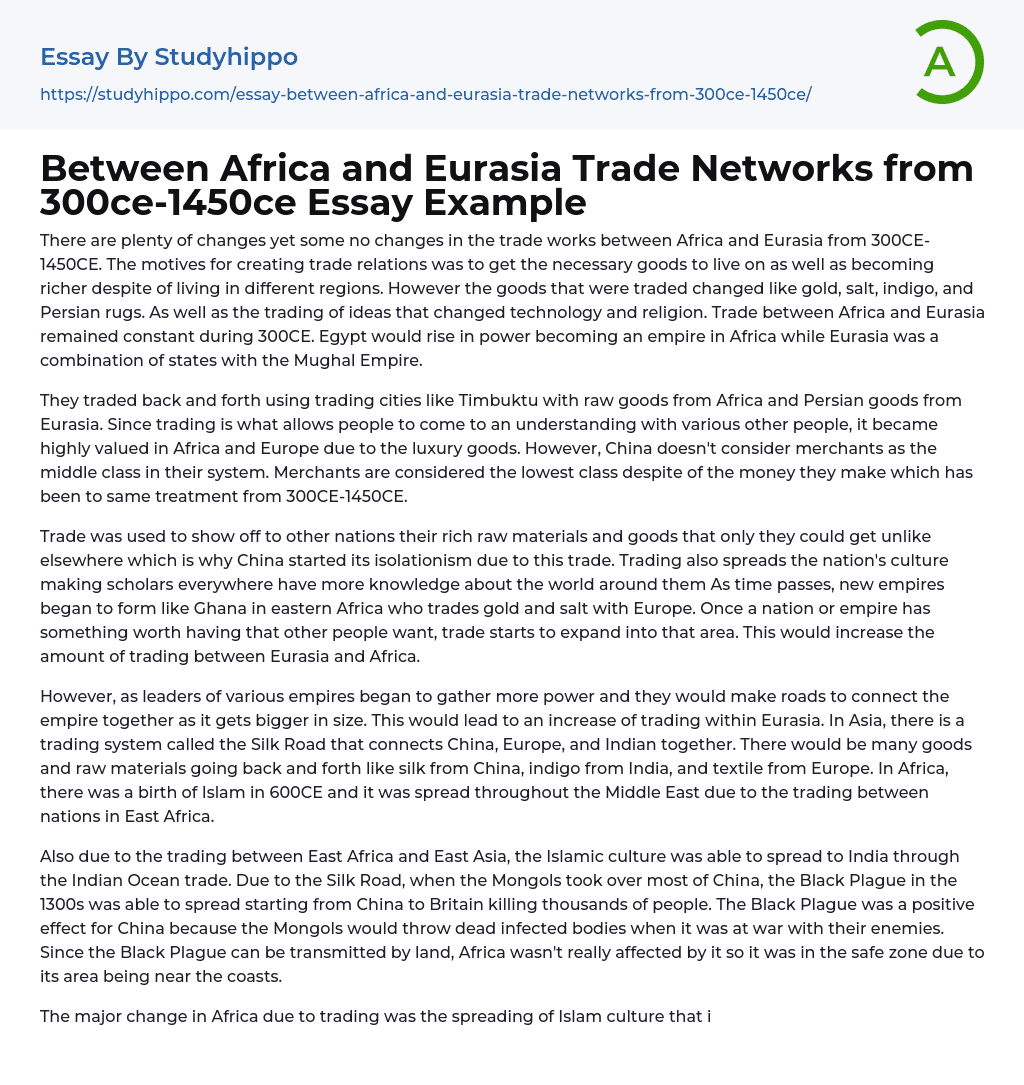

Between Africa and Eurasia Trade Networks from 300ce-1450ce Essay Example
During the period of 300CE-1450CE, trade relations between Africa and Eurasia underwent significant changes while also maintaining certain constants. The main objective of establishing trade connections was to acquire necessary goods for sustenance and increase wealth, irrespective of geographical disparities. However, there was a shift in the specific commodities traded, such as gold, salt, indigo, and Persian rugs. Moreover, the exchange of ideas through trade had a profound impact on technology and religion. Despite these alterations, trade between Africa and Eurasia remained consistent in 300CE with Egypt rising as an empire in Africa and various states like the Mughal Empire emerging in Eurasia.
From 300CE to 1450CE, trading cities like Timbuktu had a significant impact on facilitating trade between Africa and Eurasia. The exchange of goods during this period was highly valued in both regi
...ons due to the availability of luxurious items. In contrast, China viewed merchants differently and considered them as the lowest class, despite their wealth. They were not included in the middle class and this treatment persisted throughout this time frame.
Trade was used to demonstrate a nation's abundance of rare resources and exclusive goods, setting it apart from others. This inequality in trade led China to become isolated. Additionally, trade facilitated cultural exchange, allowing scholars around the world to gain a better understanding of their surroundings. As time passed, new empires like Ghana in eastern Africa emerged and traded gold and salt with Europe. The presence of valuable commodities in a specific region inevitably resulted in increased trade between Eurasia and Africa.
As the authority of leaders in different empires increased, they built roads to connect
their growing territories. This led to a rise in trade within Eurasia. The Silk Road was a major trade route in Asia that linked China, Europe, and India. It allowed for the transportation of various goods such as silk from China, indigo from India, and textiles from Europe. Moreover, trading between East African nations and the Middle East played a role in the development of Islam in Africa around 600CE.
The Indian Ocean trade enabled the exchange of goods and ideas between East Africa and East Asia, leading to the spread of Islamic culture in India. At the same time, the Silk Road played a role in transmitting the Black Plague from China to Britain after the Mongols conquered most of China in the 1300s. This outbreak caused many deaths. Interestingly, China actually benefited from this devastating plague as infected bodies were used as weapons during warfare by the Mongols. Africa, on the other hand, remained largely unaffected and safe due to its proximity to coastal areas and transmission primarily occurring through land routes.
The trade networks in Africa played a crucial role in the spread of Islamic culture and the growth of Muslim populations. These trade routes broadened people’s understanding of the world beyond their immediate surroundings. The diffusion of Islam, an instance of cultural exchange, was driven by various factors such as the need for resources like gold and salt, advancements in travel technology, and imperialistic pursuits.
- South Africa essays
- Nigeria essays
- Berlin essays
- Pompeii essays
- Paris essays
- Athens essays
- Belgium essays
- England essays
- Germany essays
- Greece essays
- Ireland essays
- Italy essays
- London essays
- Russia essays
- Spain essays
- United Kingdom essays
- Great britain essays
- Rome essays
- British essays
- Birmingham essays
- Quran essays
- Al-Qaeda essays
- Muhammad essays
- Muslim essays
- Ali essays
- Ramadan essays
- Afghanistan essays
- Africa essays
- America essays
- Asia essays
- Australia essays
- Caribbean essays
- City essays
- Developing Country essays
- Dubai essays
- Earthquake essays
- Europe essays
- Fracking essays
- Georgia essays
- Middle East essays
- Natural Disaster essays
- New Zealand essays
- North Korea essays
- South Korea essays
- Thailand essays
- Travel essays
- Afterlife essays
- Atheism essays
- Bible essays
- Buddhism essays



